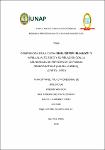Composición de la flora en el CIEFOR " El Huayo" y varillal alto seco y su relación con la abundacia de especies de la familia Dendrobatidae (Anura: anfibia), Loreto - Perú

View/
Date
2022Author
Cabudivo Escobar, Neil Anders
Mendez Lopez, Marvella
Metadata
Show full item recordAbstract
From January to september 2020 we are performed observations in the
Forestry Research and Teaching Center (CIEFOR) “El Huayo” and the White
sand forest in the National Reserve Allpahuayo Mishana (Perú) to know the
composition of the flora and its relation with the abundance of species family
Dendrobatidae, by direct observation. In the CIEFOR there are a richness of
118 species of plants with presence Aechmea moorei (Bromeliaceae) as
epiphyte and VAS 121 species of plants with Aechmea nidularioides
(Bromeliaceae) in the soil; in the CIEFOR and VAS was report 3 species of the
family Dendrobatidae: Ranitomeya reticulata, Ranitomeya amazonica and
Ameerega hahneli, where Ranitomeya reticulata report a density greater than
the other species. We conclude that the flora CIEFOR and VAS they favor the
survival and abundance of Ranitomeya reticulata, Ranitomeya amazonica and
Ameerega hahneli. De enero a setiembre de 2020 se realizaron observaciones en el Centro de
Investigación y Enseñanza Forestal (CIEFOR) “El Huayo” y el Varillal Alto
Seco (VAS) de la Reserva Nacional Allpahuayo Mishana para conocer la
composición de la flora y su relación con la abundancia de especies de la
familia Dendrobatidae, mediante observación directa. El bosque transicional
del CIEFOR se reportó una riqueza de plantas de 118 especies con presencia
de Aechmea moorei (Bromeliaceae) como epífita y en el VAS 121 especies
de plantas con Aechmea nidularioides (Bromeliaceae) en el piso del suelo; en
ambos bosques se reportaron 3 especies de la familia Dendrobatidae:
Ranitomeya reticulata, Ranitomeya amazonica y Ameerega hahneli, de los
cuales Ranitomeya reticulata reportó una mayor densidad con respecto a las
otras especies. Se concluye que la flora del CIEFOR y VAS favorecen la
supervivencia y abundancia de Ranitomeya reticulata, Ranitomeya amazonica
y Ameerega hahneli.
Collections
- Tesis [419]

